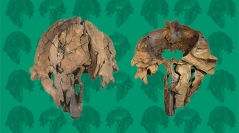

 Comptes Rendus Palevol
20 (39) - Pages 807-822
Comptes Rendus Palevol
20 (39) - Pages 807-822In spite of a continuously expanding physeteroid fossil record, our understanding of the origin and early radiation of the two modern sperm whale families Kogiidae Gill, 1871 (including the pygmy and dwarf sperm whales, Kogia spp.) and Physeteridae Gray, 1821 (including the great sperm whale, Physeter Linnaeus, 1758) remains limited, especially due to the poorly resolved phylogenetic relationships of a number of extinct species. Among those, based on fragmentary cranial material from the late early to middle Miocene of Antwerp (Belgium, North Sea basin), the small-sized Thalassocetus antwerpiensis Abel, 1905 has been recognized for some time as the earliest branching kogiid. The discovery of a new diminutive physeteroid cranium from the late Miocene (Tortonian) of Antwerp leads to the description and comparison of a close relative of T. antwerpiensis. Thanks to the relatively young ontogenetic stage of this new specimen, the highly modified plate-like bones making the floor of its supracranial basin could be individually removed, a fact that greatly helped deciphering their identity and geometry. Close morphological similarities with T. antwerpiensis allow for the reassessment of several facial structures in the latter; the most important reinterpretation is the one of a crest-like structure, previously identified as a sagittal facial crest, typical for kogiids, and here revised as the left posterolateral wall of the supracranial basin, comprised of the left nasal (lost in kogiids for which the postnarial region is known) and the left maxilla. Implemented in a phylogenetic analysis, the new anatomical interpretations result in the new Belgian specimen and T. antwerpiensis being recovered as sister-groups in the family Physeteridae. Consequently, the geologically oldest kogiids are now dated from the Tortonian, further extending the ghost lineage separating these early late Miocene kogiid records from the estimated latest Oligocene to earliest Miocene divergence of kogiids and physeterids.
Cetacea, Physeteridae, Kogiidae, Thalassocetus, late Miocene, North Sea